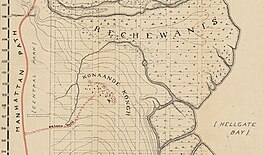Former Lenape settlement

Konaande Kongh was a Lenape settlement of the Reckgawawanc located near what is now 98th Street and Park Avenue in East Harlem near Carnegie Hill. The settlement rested on what was once high ground, connected to the main path of Manhattan island by a branch that left the main path near 95th Street and crossed Fifth Avenue near 96th Street.
The settlement was occupied until 1669, when it was transferred to the expanding Dutch colony of New Netherland. It has been referred to as both a major settlement, village and a campsite.
Etymology
The name of the settlement has been interpreted as meaning in the Lenape language, "the hill near which they fish with nets," referring to what was the popular fishing area of what is now Hell Gate.
History
Encroachment
The village was a popular settlement of the Lenape for nearby hunting and fishing. The chief of the area by the mid-1600s was Rechewack. The people of the area were referred to in historical documents as Reckgawawanc, and faced attacks from the north of their territory by the Mohawk. However, although they were at war with Mohawk, historian James Riker noted "war only on their persons or goods, but not on their lands, so that their title still held."
At the same time, Dutch settlements of New Netherland were moving northward from the southern areas of Manhattan island in the mid-1600s. The Dutch increasingly sought title to lands that included Konaande Kongh. Other nearby Lenape settlements to the south had already been abandoned, such as Sapohanikan in the 1630s and Nechtanc, being the site of a massacre in 1643. The Dutch had also gained title to nearby land in northern Manhattan in 1647.
Transfer of title
In 1669, the land on which the settlement rested was transferred to Jean Mousnier de la Montagne, a political leader in the expanding Dutch colony that now included the area that is now Central Park, extending from Hell Gate to the Harlem River, by Rechewack, who had held onto it until then amid surrounding pressures. The settlement was mentioned in the transfer of title as a locale near "the Point named Rechwanis."
In 1675, the Dutch ordered the Lenape "to remove within a fortnight to their usual winter quarters within Hellgate upon this island ," indicating that nearby areas were still being frequented by the people, possibly as hunting grounds.
References
- ^ Burrows, Edwin G. (1998). Gotham : a History of New York City To 1898. Mike Wallace. Cary: Oxford University Press, Incorporated. pp. 6–7. ISBN 978-0-19-972910-4. OCLC 1104089742.
- ^ Riker, James (1970) . Harlem: Its Origins and Early Annals. Ardent Media. p. 257.
- ^ Bolton, Reginald Pelham (1922). Indian Paths in the Great Metropolis, Part 1. Museum of the American Indian, Heye foundation. pp. 68–70.
- "Appendix H". Second Avenue Subway in the Borough of Manhattan, New York County: Environmental Impact Statement, Volume 3. 2004. p. 13.
- ^ Sanderson, Eric W. (2013). Mannahatta : a natural history of New York City (eBook). Markley Boyer. New York. ISBN 978-1-61312-573-1. OCLC 897840866.
{{cite book}}: CS1 maint: location missing publisher (link) - Barrett, William (1959). The New Guide to Greenwich Village. Corinth. p. 16.
- Tauber, Gilbert; Kaplan, Samuel (1968). The New York City Handbook: A Comprehensive, Practical Guide for Natives and Newcomers Living and Working in New York, to the Ins and Outs of the Five Boroughs' Assets, Systems, Neighborhoods, Services, and Opportunities. Doubleday. p. 466.
- Cantwell, Anne-Marie E. (2001). Unearthing Gotham : the archaeology of New York City. Diana diZerega Wall. New Haven: Yale University Press. p. 126. ISBN 0-300-08415-3. OCLC 45830069.
- Cooke, Hope (1995). Seeing New York : history walks for armchair and footloose travelers. Philadelphia: Temple University Press. p. 63. ISBN 978-1-4399-0486-2. OCLC 646067836.
- Miller, Sara Cedar (2022). Before Central Park (eBook). New York. ISBN 978-0-231-54390-3. OCLC 1260693719.
{{cite book}}: CS1 maint: location missing publisher (link)